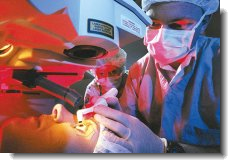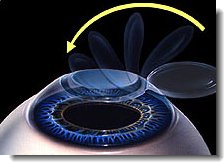
The Types Of Laser Eye Surgery
The idea of actually changing the shape of your cornea to correct vision problems is relatively new. The first of three methods to be developed was called "Radial Keratotomy" (RK), in which a nearsighted person's cornea is reshaped with a diamond-bladed knife to within 90% of the depth of the cornea. This procedure is done without the aid of computers and lasers. RK first appeared in the United States in 1986, but has since been abandoned for the more advanced laser treatments. The second and third procedures to emerge were "Photorefractive Keratectomy" (PRK) and "Laser In Situ Keratomileusis" (LASIK). These are technical terms for what amounts to removing very small amounts of corneal tissue to change the way light is refracted (bent) by the cornea. Most doctors now recommend LASIK to their patients.
What Is The Difference Between LASIK And PRK?
The biggest difference between LASIK and PRK is that with PRK, the surgeon completely removes the outermost corneal cell layer (the epithelium) before performing the laser procedure. The patient then must wait for this cell layer to grow back, which can take anywhere from 3 to 5 days. In LASIK, a layer of tissue is created by an instrument called a microkeratome. This layer remains attached to the eye by a strip of tissue that forms a hinge, like a door attached to a frame. The flap is then lifted up and folded over, out of the path of the laser. The laser is concentrated WITHIN the cornea on the part of the eye called the "stroma". After surgery the flap is folded back to its original position, and remains in place using natural adhesion forces, with no stitches. With PRK, protective contact lenses are sometimes worn for a few weeks or more to aid in the healing process. The visual outcome for most patients is excellent with both PRK and LASIK, although there are some differences you should know about:

Pain And Recovery Times:
PRK patients will definitely experience more discomfort than LASIK patients both during and after surgery. Some PRK patients also experience photophobia, or an unusually strong sensitivity to light, for the first few weeks. Overall, PRK is a more invasive procedure, and patients generally wait longer for their vision to stabilize (in some cases, up to six months). LASIK patients have a shorter recovery time, much less pain, and tend to have more "instant" results when it comes to clarity of vision.

Am I Missing Something? Why Would Anyone Choose PRK Over LASIK?
Well, in some cases your corneal layer may be too thin for the surgeon to create a proper flap. Or it will be thick enough to create a flap, but not thick enough to create a second one in case a corrective procedure is required. This means you will have no choice but to have the PRK procedure performed as opposed to LASIK.
There are also some concerns about the corneal flap created in LASIK. Because the flap generally heals around the edges only, there have been reported cases of the flap dislocating, sometimes even months after the procedure is performed. This requires another visit to the surgeon for correction. Reported problems with light halos and and night vision are also more common with LASIK.
There are also some concerns about the corneal flap created in LASIK. Because the flap generally heals around the edges only, there have been reported cases of the flap dislocating, sometimes even months after the procedure is performed. This requires another visit to the surgeon for correction. Reported problems with light halos and and night vision are also more common with LASIK.
It is important that you ask your potential surgeon about the differences between the two treatments and research both procedures from as many unbiased sources as possible!
Also See:
Also See:
Contact Lenses | Glaucoma | Just For Fun | Eyeglasses | Eye Doctor | Eye Care And Symptoms | Eye Anatomy | Online Eye Tests | Laser Eye Surgery | Laser Eye Surgery Directory: Canada | Laser Eye Surgery Directory: USA | Laser Eye Surgery Reviews | Submit A Review | Contact Us | Privacy Policy | Sitemap
Copyright 2006-2009 Vision Health

